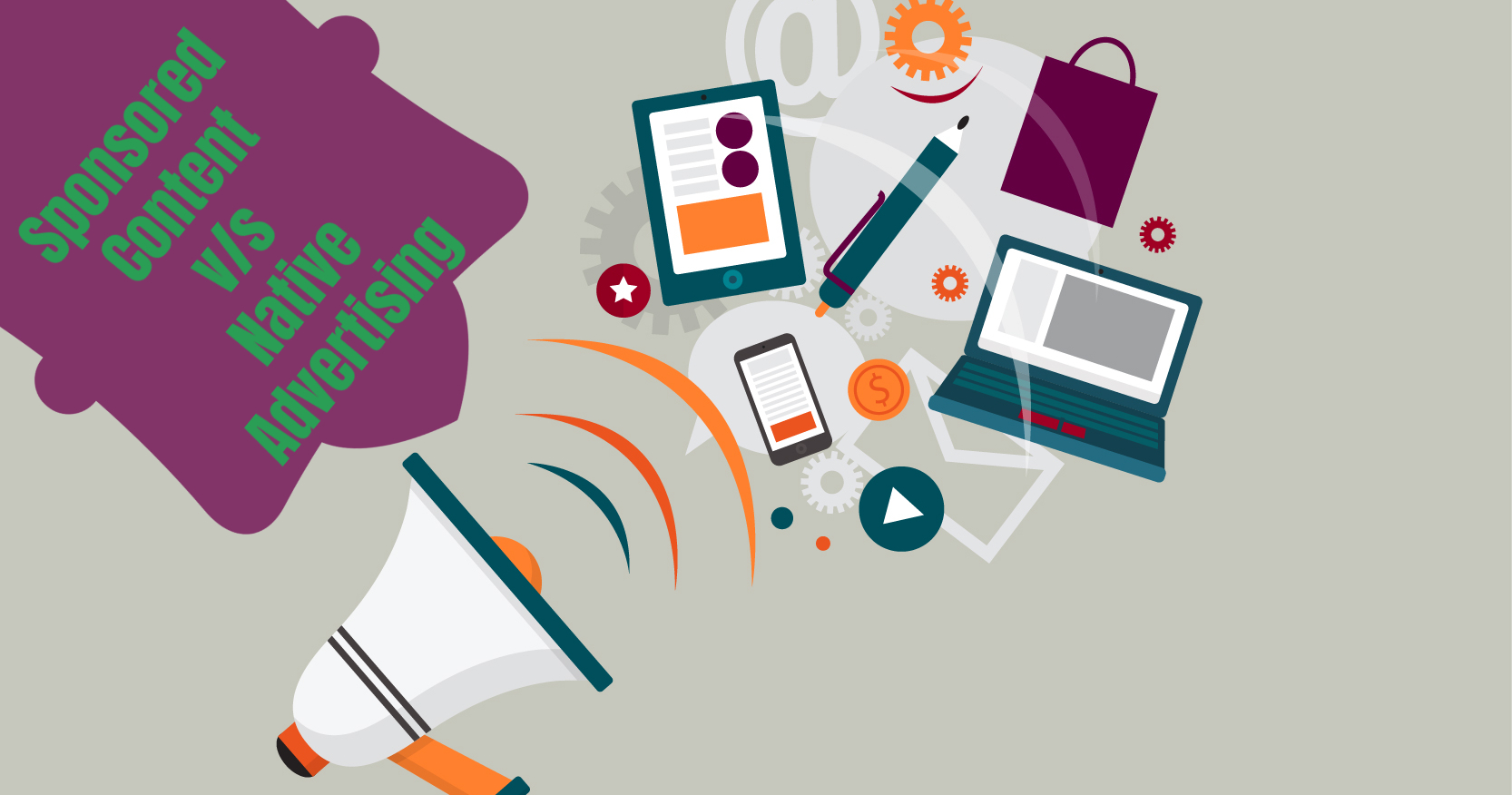
When it comes to online marketing, marketers have lots of options. You must have heard “Content is king”. As content marketing is growing, buzzwords connected to it also growing. Sponsored posts and Native advertising are two buzzwords freshly. There is much similarity between both of them as both are a paid form of advertisement but then also have some difference.
While most of the times these two terms are interchangeably be used. They have something in common. Also, there are circumstances where one is more appropriate than another.
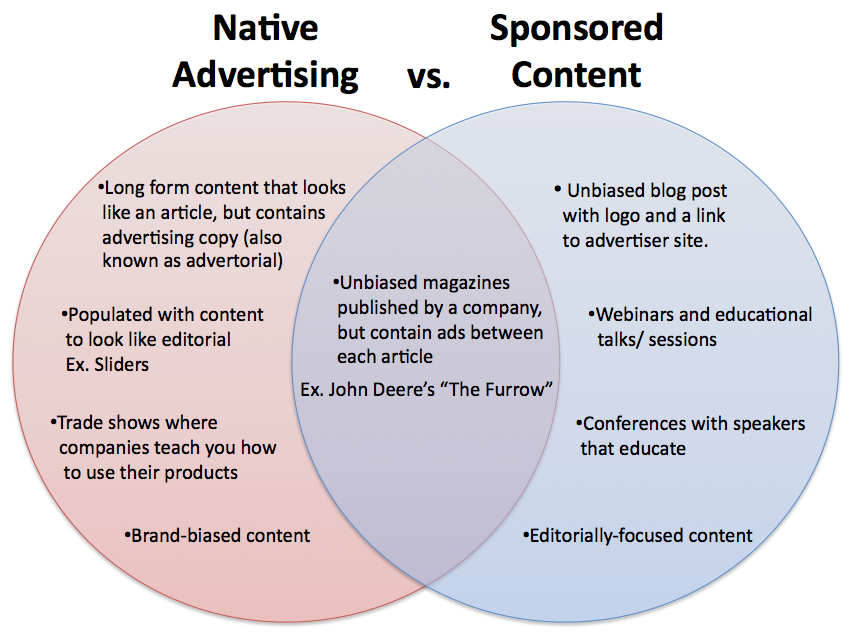
There is not much difference in sponsored posts and native advertising. The native advertising is like a traditional ad and sponsored content is more like a media placement.
Native ads and sponsored content are the two sides of the same coin. By this I mean to say that the both are a form of paid internet advertisement that fit the form and function of the surrounding editorial content on the webpage.
Well, both Sponsored ads and Native ads are part of paid advertising. Both blend well with the webpage on which they reside. Each one of these has a different purpose and will be most effective depending on what your brand hopes to achieve. Through this post, you will get an idea, when to use native ads and sponsored content, and show what they look like.
What is Sponsored Content?
Sponsored content involves paying a person, account or company to promote your business using intentionally targeted content. Often times, the business doing the marketing (you) writes a blog or creates a campaign idea and pays another platform to post it.
The goal of a successful Sponsored content campaign is to inform the audience rather than to convince them. It usually has a call to action and sometimes referred to as “advertorials”. This is not brand-biased but totally editorial with a little hope that the reader will enjoy their content.
Sponsored content is a paid form of promotion in which the advertiser pays a sum of money to an advertiser, to create and promote advertiser’s product on multiple platforms.
The goal of sponsored content is to widen your audience to reach and gain brand exposure. There’s also the added benefit of tying your name to a reputable or popular source. You’ll often see this advertising in the form of:
- Professional bloggers writing about a certain product
- Social media influencers promoting a brand
- “Listicles” (list-articles) that appear organic but slip a brand name or product in the content
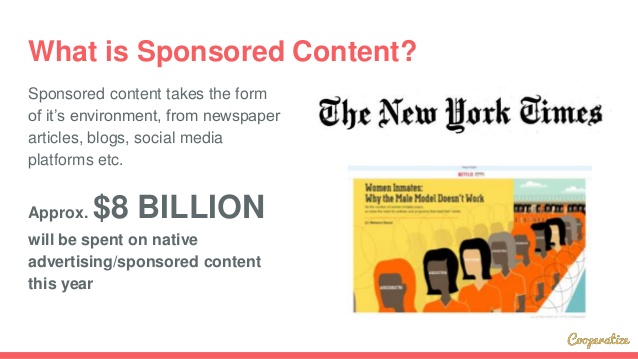
While sponsored content comes under the umbrella of native advertising, but not all native ads are sponsored content. As a marketer, you can direct the message and even create the copy and don’t require the involvement of another platform. Some publishers have teams dedicated to creating sponsored content for their brand partnerships.
Sponsored content is less confining than native advertising and publishers give brands scope to be creative and engaging, as long as the post is cleared marked as “sponsored” or “promoted”. This also means that brands can mention a product or service and include a call to action (CTA).
What type does it look like?
These posts are can be any form whether it is an article, video or in the form of a listicle, they just appear the native part of the website.
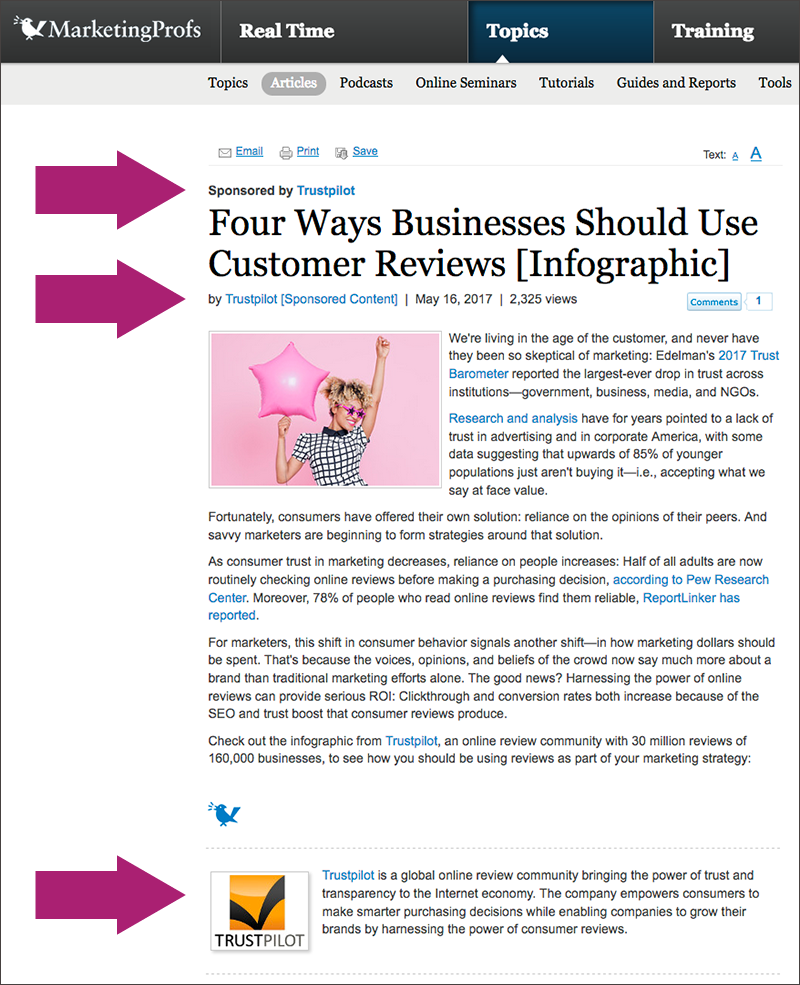
Many big brands and publishers on media sites like BuzzFeed, Forbes, New York Times and others collaborate with each other to develop a content studio to create and sponsored content.
Why spend hundreds of dollars on sponsored content?
Many businesses are continuously publishing a helpful article to position themselves as an expert or a major storytelling voice in their field. The main reason behind this is to establish trust with customers so they can rely on the companies information and products.
One of the main reasons behind publishing a sponsored post on other websites as it leads to promotion and also helps to see a jump in sales after publishing. A sponsored post is considered as a short term investment by contentmarketing.com but irrespective of this there is a long term benefit of publishing sponsored posts. As viewers may not regularly purchase your product but they may regularly follow your post and engage with your brand.

Qualities of a great Sponsored post
Sponsored ads offer content for the viewer who is interested without disturbing others who are not. And If you are thinking of creating a sponsored ad or content. Then make sure your content is:-
- Engaging– The content must be more engaging as it will help in more conversions or redirection towards your page.
- Interesting– The sponsored ad must be more interesting i.e it attracts and converts more visitors.
- Should not be fake– The ad must not be fake or misleading as it will degrade your value.
- Useful for the audience– The sponsored post must be useful for the audience.
- Well-written– The posts must be well-written as it must interest the reader’s sentiments and completes the user’s intent of clicking the ad.
What is Native Advertising?
Native advertising is an umbrella term for ads that mirror the environment in which they appear. This type of ads are appearing in the top in the location-based google search result and look similar to organic results on the page
Native advertising is more promotional in nature because it focuses on convincing the viewer rather than informing them. And sometimes Native ads blend so well with the website content so viewers may think that content is written by the website’s publisher or editorial instead of a paid promotion.
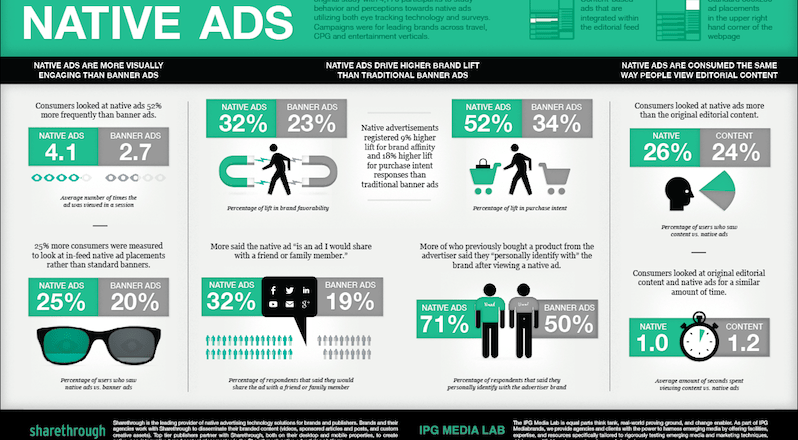
A native ad resides on a webpage and connects to either sponsored, owned or earned media, really, anything the brand wants people to read. Once you click on the ad, it will likely send you to a lightly branded article. You’ll usually see a couple of brand mentions as well as a call-to-action (CTA). The most productive types of native ads are those that provide practical, actionable value for the reader.
Native ads come in many different forms. We deal primarily with paid search ads such as pay per click (PPC) ads, but there are several other types out there you can use in your digital strategy. This could include:
- Promoted listings on e-commerce sites
- Social media display ads
- Recommended content on news or entertainment sites
- Location-based ads within apps
- Paid search ads

These are just a few examples of native ads you could utilize in your marketing campaign. Native ads have the potential of long shelf life, unlike traditional display ads. Because these content are hosted on a webpage (such as on your blog) and you may continue seeing organic traffic from social media shares even once the native ad campaign is complete.
What does it look like?
As described above in the features section that they look like as a native part of the publisher’s website and can be in the form of articles and websites. Mainly it can be five types-
- In-feed ads (on publishing websites as well as social platforms)
- Paid search ads (on the top of the platform)
- Recommendation widgets (Outbrain, Taboola, and many others)
- Promoted listings (on shopping websites like Amazon or eBay)
- In-ad with native element units by platforms.
In the above-given cases, the ad looks like they are surrounding content. For example, if you are searching for a jacket then you can see a prompted post beneath or on one side. These posts are labeled with an advertisement.
The Good And Bad Sides of Native Advertising
Native advertising may not be suitable for every marketer. Whether it is a sponsored listing, a traditional advertisement or sponsored content, there are many pros and cons to consider.
Pros:
- Native advertising is not irritating to readers because it is similar to the content they came to see on the website.
- It’s difficult for ad blockers to block native advertising because it appears to be part of the website content.
- Placing ads, right in the halfway of the website content, means that the potential buyers are already there.
- They seem trustworthy since the reader already likes and trusts the website they are browsing.
- They are more effective.
- These are the best ways of increasing website traffic into leads
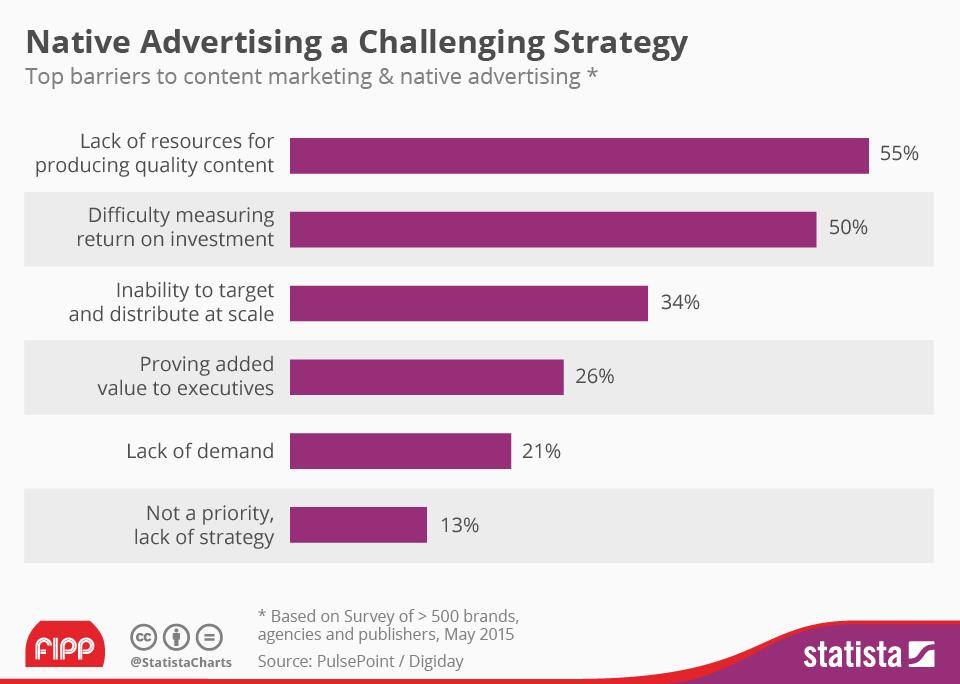
Cons:
- If the ad doesn’t contain relevant sponsored content, readers can feel as though you’ve fooled them.
- The audience with a bad experience with a native ad may establish negative feelings toward your product or service.
- It may be overpriced compared to other marketing methods.
When You Should Use Them
Like any facet of digital marketing, there’s a time and a place for everything. The same goes for sponsored content and native ads. When deciding what type of advertising strategy you want to employ, you need to determine the goal of this campaign. If your goal is to:
Get more brand exposure
Sponsored content is the way to go if you aim to familiarize more people with your company’s name. If a well-known company or industry blogger mentions your name in his/her content, you’re reaching a much wider audience than you would on your own.
Gain more high-quality leads
Stick to native advertising like pay per click (PPC). These ads show up when searchers are looking for your specific products and are ready to buy in, so your ad will be in the right place at the right time.
Quickly sell a particular product
Well known and people already searching for a product and pretty easy to sell and the PPC is the best option for it, but if a product is newer and less known, then the sponsored content by an industry-trusted brand that helps you to bring attention to your product immediately.
Promote a certain location
Use location-based native ads. No matter what platform you’re using, ads that target your products/services within a specific location will be more appealing to consumers in that area, especially for local small businesses.
Advertising Made a Little Easier
No one ever said advertising would be a walk in the park. Choosing the right type of ads based on your marketing goals is just one of those hurdles. And making the right decision starts with understanding the differences between sponsored content and native advertising. In today’s marketing landscape, paid media is a necessary strategy to reach your target audience and achieve inbound marketing goals.
A small brief…
Advertising can be an important part of your marketing strategy, specifically when its sponsored content. It provides you with a chance to get more creative and keep your reader engaged through creative content.
If used properly the advantages of native advertising are significant. And it’s clear that it is the growing popular form of advertising. As long as you keep the following rules and keep creating interesting and relevant content, the advantages of native advantages will continue to exceed.
Difference between sponsored content and native advertising
Format
The main difference between both is the format of each of them. As in native advertisement, you can only publish content in-post ads, paid search ads, recommendation widgets, promoted listing and custom ads.
But in sponsored content, you can include articles, listicles, video, photo, infographic and many more. As you can see a list in sponsored content which is popular on social media and each social media has a massive audience of social users which makes the social feed a natural fit for a Sponsored post.

Views
In today’s scenario banner ads are no more helpful and even promoted listings do not perform very well. But many studies show that people don’t hate each and every ad. In this sponsored content offers a solution by placing an ad in between.
On Facebook and Linked-In timeline, any other sponsored post looks like any user status update. The display of sponsored content draws attention and directs it to the actual post.
The sponsored is becoming that popular and native that consumers couldn’t tell the difference between the two. Due to this reason, the federal trade commission stepped in for providing some assistance.
Uses
Sponsored post leads to higher engagement and it all is because of their interest. Reuters found in their survey that nearly 75% of customers engage when the content piques their interest. Whereas it increases the brand value as they are promoted by reputed brands.
Native ads are also having a higher CTR of nearly 5-8x higher than banner ads. And native ads are especially better for mobile and handy portable devices where the tenure of time spent is day by day increasing. A recent study of hacker noon found that in a month 86 hours are spent on mobile for consuming content and making the purchase. Here the native ads are used for brand promotion and continuous delivery of the content to customers even if they are not making a purchase.
Result
The result of both of them is exponentially big where one i.e (Sponsored post) is promoting for generating a huge user base for the new product.
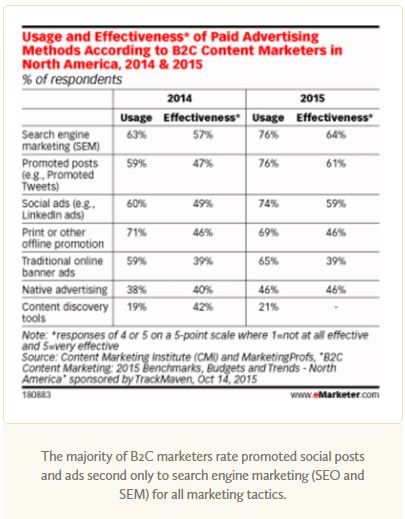
Where the latter one(Native ads) is creating a long-lasting relationship with your customer by continuously providing the content in the social feed.
Conclusion (Which one is better)
In today’s marketplace paid media is necessary to reach out to your target market and fulfill your brand goals. Both are the paid forms of content and are a subset of content marketing that helps you with your goals. So, whether Sponsored content or Native content is great for your brand? This totally depends on a company’s marketing strategy and objectives.
You must use both of them when you want to launch your own product then sponsored post is a better option as it provides a strong base for general awareness. Sponsored post are only done by big and well-known companies/brands for a specified sum. Whereas native ads are the best option after establishing your business which is continuously helpful for building a long-lasting relationship.
